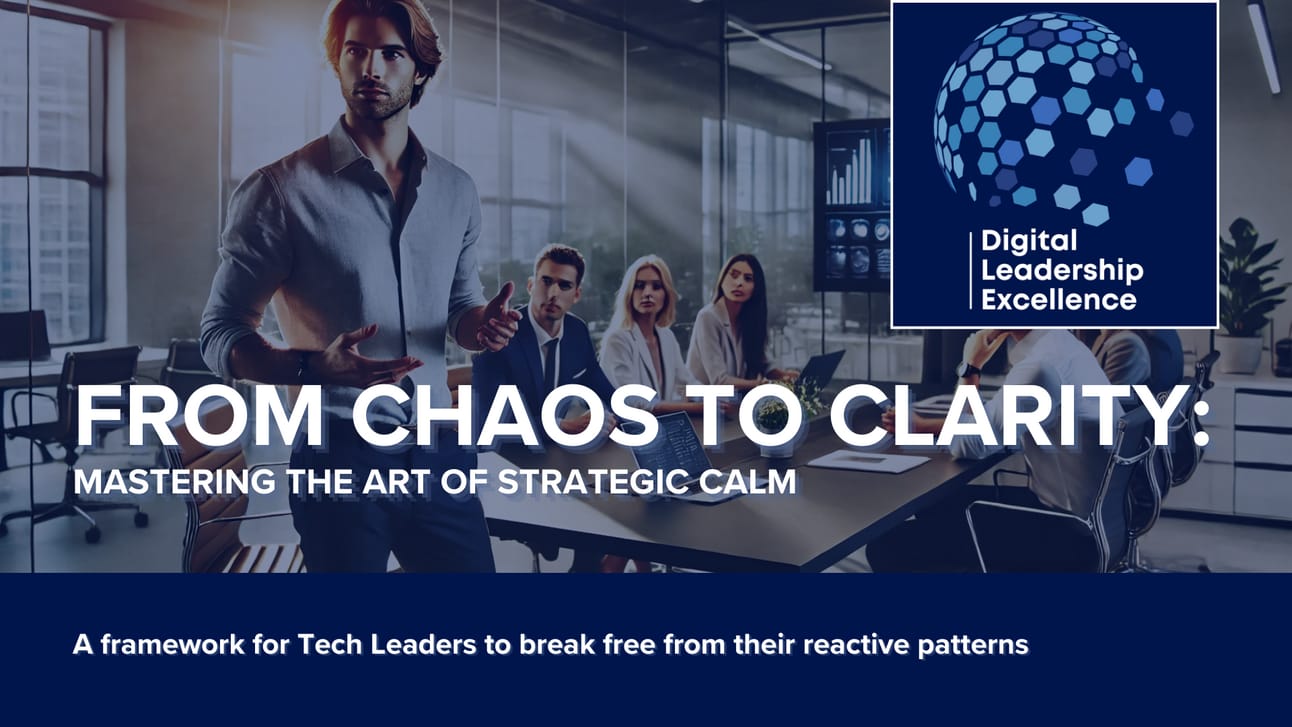Greetings, and welcome to Digital Leadership Excellence—your trusted weekly guide to excelling in tech leadership, delivering results, and thriving with clarity and purpose. In every issue, we provide insights into winning strategies, growth tactics, and practical solutions, designed to support both current and aspiring technology leaders navigating the ever-evolving digital world.
1.0 Introduction
Picture this…
It's 3 AM, and your phone buzzes to life. Another "critical" system alert. Another "emergency" that just can't wait until morning. Another moment where you're forced to choose between strategic leadership and tactical firefighting.
Sound familiar?
You're not alone. And here's the thing - it's not entirely your fault.
Let me share something that might hit close to home...
Last month, I sat across from James, a brilliant CTO at a rapidly growing tech company. His eyes were bloodshot, his hands shaking slightly as he clutched his fourth coffee of the morning.
"I feel like I'm drowning," he confessed. "Every time I try to think strategically, another crisis pulls me back into the weeds. I'm supposed to be leading digital transformation, but I can't transform anything if I'm constantly putting out fires."
I see this pattern EVERYWHERE in technology leadership. Brilliant minds trapped in reactive cycles, their potential locked away behind an endless wall of "emergencies."

But here's what most people miss...
The problem isn't the chaos. The problem is how we're TRAINED to respond to it.
Think about it...
How did you get to where you are today? Chances are, you built your career on being the person who could solve any technical problem. The go-to expert. The reliable firefighter.
That strength? It's now your biggest limitation.
Let me show you why...
2.0 An Endless Loop
Your brain has been wired through YEARS of experience to:
Jump into action at the first sign of trouble
Take personal responsibility for technical issues
Pride yourself on quick problem-solving
In other words, you've developed what I call the "Reactive Responder" pattern.
And it's killing your ability to lead strategically.
Here's the data that shocked me:
After analyzing over hundreds hours of coaching sessions with technology leaders, I discovered that:
Most "emergencies" were predictable and preventable
The vast majority of them could have been handled by well-trained teams
Leaders reported missing strategic opportunities because of tactical firefighting

But here's where it gets interesting...
The top 5% of technology leaders - the ones driving real transformation and innovation - didn't have fewer problems than everyone else.
They just had a completely different RELATIONSHIP with those problems.
They had mastered what I call "Strategic Calm" - the ability to maintain strategic focus and presence even in the midst of chaos.
And it all starts with understanding three critical truths:
Your availability is training your organization
Your response to chaos is shaping your culture
Your relationship with "emergencies" is either building or limiting your leadership impact
3.0 Breaking Free
Now that we understand WHY we get trapped in reactive patterns, let's talk about how to break free.
Remember James, our coffee-clutching CTO?
Three months after implementing the framework I'm about to share, he sent me this text:
"First full night's sleep in years. Team handled everything. Actually excited about our strategy meeting tomorrow."
So what changed? Everything. And nothing.
The chaos was still there. The technical challenges hadn't disappeared. But James had transformed his relationship with them through what I call the Strategic Calm Framework.
Here's how it works:
STEP 1: Recognize Your Reactive Triggers
Most technology leaders have specific triggers that activate their "firefighter mode":
System outages
Security alerts
Performance issues
Stakeholder complaints
The key isn't to eliminate these triggers - it's to RESPOND rather than REACT to them.
Here's the game-changing question James started asking: "Is my presence REQUIRED here, or just REQUESTED?"
This simple distinction changed everything.
STEP 2: Implement the Eisenhower Matrix
Every issue gets categorized across two dimensions:
Impact (High/Low)
Urgency (Real/Perceived)
But here's the crucial part - you're not just categorizing the issue itself, but the PATTERN it represents.
For example: A server outage = Urgent issue; Recurring server outages = Strategic opportunity for infrastructure improvement
This shift in perspective helps you:
Delegate effectively
Build preventive systems
Focus on root causes
Maintain strategic focus

STEP 3: Build Your Strategic Buffer
The most successful technology leaders I've coached all have one thing in common: They create SPACE between stimulus and response.
Here's how:
The 10-Minute Rule
Wait 10 minutes before responding to any "emergency" (unless it's truly life-or-death). This pause helps you:
Assess real urgency
Identify patterns
Consider strategic implications
The Pattern Protocol
For every crisis, document:
Root cause
Response required
Prevention opportunity
Strategic implication
The Delegation Design
Create clear frameworks for:
What your team can handle independently
What requires consultation
What needs your direct involvement
Transform Your Team
Here's where the magic really happens...
Start treating every "emergency" as a training opportunity:
Guide your team through problem-solving instead of solving problems for them
Create decision-making frameworks instead of making all decisions
Build response protocols instead of being the primary responder

4.0 What’s Next
The results?
Within 90 days, James saw:
Significant reduction in after-hours calls
Major increase in strategic planning time
Large improvement in team problem-solving capability
But the biggest transformation?
His presence as a leader.
When you're not constantly reacting to chaos, you can finally start LEADING with intention.
Your Next Steps
Track Your Triggers - For the next week, document every "emergency" that pulls you from strategic work.
Apply the Matrix - Categorize these issues using the Eisenhower Matrix.
Build Your Buffer - Implement the 10-Minute Rule unless truly critical.
Transform One Pattern - Choose one recurring "emergency" and build a system to prevent it.
Remember: Strategic calm isn't about having fewer problems. It's about having a different relationship with those problems.
Ready to transform your leadership presence?
Let me know in the comments:
What's one "emergency" pattern you're ready to transform into a strategic opportunity?



